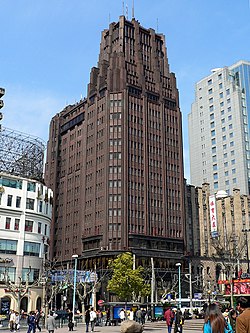| László Hudec | |
|---|---|
 | |
| Born |
January 8, 1893 Besztercebánya, Austria-Hungary (today Banská Bystrica, Slovakia) |
| Died |
October 26, 1958 (aged 65) Berkeley, California, United States |
| Nationality | Hungarian, Slovak |
| Other names | Ladislav/László/Ladislaus/Ladislaw Hudec |
| Citizenship |
Hungarian (1893-1921) Czechoslovak (1921-1941) Hungarian (1941-) |
| Alma mater | Budapest University |
| Spouse(s) | Gizella Mayer |
László Ede Hudec[1] or Ladislav Hudec (Hungarian language: Hugyecz László Ede)[1] (Besztercebánya, Austria-Hungary (now Banská Bystrica, Slovakia) January 8, 1893 – Berkeley, October 26, 1958), Chinese name Wu Dake (Chinese: 鄔達克), was a Hungarian[2][3]–Slovak[4][5] architect active in Shanghai from 1918 to 1945 and responsible for some of that city's most notable structures. Major works include the Park Hotel, the Grand Theatre, the Joint Savings and Loan building, the combined Baptist Publications and Christian Literature Society buildings, and the post-modern "Green House". Hudec's style evolved during his active period, from the eclectic neo-classicism popular in the early 20th century to art deco and modern buildings toward the later part of his career. Although some of his buildings have been lost in the intervening decades, many survive.
Biography[]

László Hudec around 1934
Hudec was born in 1893 in Besztercebánya, Austria-Hungary (now Banská Bystrica in Slovakia).[5] His father, György Hugyecz was a wealthy Magyarized[note 1] Slovak[4][6][7] architect, born in the nearby village of Felsőmicsinye (now Horná Mičiná), while his mother, Paula Skultéty was an ethnic Hungarian[4] from Kassa (Košice). He studied architecture at Budapest University from 1911 to 1914.[8] As a patriotic Austro-Hungarian citizen,[5] Hudec volunteered to join the Austro-Hungarian Army after outbreak of World War I, but was captured by the Russian Army in 1916 and was sent to a prison camp in Siberia.[5] While being transferred, he jumped from a train near the Chinese border and made his way to Shanghai, where he joined the American architectural office R. A. Curry.[8]
In 1925, he opened his own practice,[8] and was responsible for at least 37 buildings up to 1941.
After the Munich Agreement, (1938) Hudec lost his Czechoslovak citizenship and applied to become Hungarian citizen.[5] In 1941 he obtained a Hungarian passport and was appointed Honorary Consul of Hungary in Shanghai.[5]
Hudec's masterpiece is usually considered to be the 22-story Park Hotel Shanghai, on Nanjing Road across from People's Square. Built in 1934, it was the tallest building in the city until the 1980s, and is still a local landmark.
After leaving Shanghai in 1947, Hudec moved to Lugano and later to Rome. In 1950 he moved to Berkeley where he taught at the University of California. He died from a heart-attack during an earthquake in 1958. In 1970 his remains were buried in an evangelical cemetery in Banská Bystrica.[9]
Buildings in Shanghai[]

Park Hotel Shanghai, 1934
- American Club, Shanghai
- Country Hospital
- Paulun Hospital (Chinese: 保龙医院)
- Margaret Williamson Hospital (Red House Hospital)
- Moore Memorial Church (Chinese: 沐恩堂)
- German Church (Chinese: 上海德国礼拜堂)
- Chapei Power Station (Chinese: 闸北水电厂)
- China Baptist Publication Society and Christian Literature Society Building (Chinese: 真光大楼)
- Union Brewery
- Grand Theatre
- Park Hotel Shanghai
- Dr Woo's villa (Green house) (Chinese: 吴同文住宅)
- Avenue Apartments
- Wukang Mansion (Normandie Apartments)
- Hudec House (Chinese: 邬达克公馆)
- Columbia Circle (Chinese: 哥伦比亚住宅圈)
- Columbia Country Club (Chinese: 美国乡村总会)
References[]
- ↑ 1.0 1.1 "Life and work; Roots". Ministry of Culture and Education of Hungary; College of Architecture and Urban Planning of Tongji University. www.hudec.cn. 2008. Archived from the original on October 3, 2011. https://web.archive.org/web/20111003155911/http://www.hudec.sh/index.php?id=33. Retrieved May 17, 2011.
- ↑ Wasserstrom, Jeffrey N. (2009). Global Shanghai, 1850-2010: a history in fragments. Routledge. p. 102. ISBN 9780415213288.
- ↑ Wang Zhiyong (April 23, 2009). "'Hudec and Shanghai', Deke Erh Photography Exhibition". China Internet Information Center. http://www.china.org.cn/travel/expo2010shanghai/2009-04/23/content_17661535.htm. Retrieved September 4, 2010.
- ↑ 4.0 4.1 4.2 Csejdy, Júlia (2009). "Besztercebányától Sanghajig. Hugyecz László építész (1893-1958) életpályája" (in Hungarian). Hudec Heritage Project. Archived from the original on March 9, 2012. https://web.archive.org/web/20120309112849/http://www.epiteszet.hudecproject.com/hu/essays/besztercebanyatol-sanghajig-hugyecz-laszlo-epitesz-1893-1958-eletpalyaja. Retrieved May 17, 2011. ""Hogy vajon magyar vagy tót vagyok, én nem tudom, nem is keresem, magamat széjjel nem vághatom, mint szétvágták hazámat, mindig az maradok, ami voltam. Nem kérdezte senki tőlem a régi szentistváni Magyarországon, hogy vajon tót vagyok-e vagy magyar? Szerettem mindkettőt, hiszen anyám magyar, apám tót származású volt, és én is mind a kettő voltam." Full translation: "Whether I am Magyar [Hungarian] or Tót [Slovak], I do not know, and neither do I search [my roots], I cannot cut myself into parts, as my fatherland [Kingdom of Hungary] was carved up, I'll always remain, what I have been. In the old Hungary of [King] St. Stephen no one asked me whether I was Tót or Magyar? I loved them both, since my mother was Magyar, and my Father of Tót ancestry, and I myself was both.""
- ↑ 5.0 5.1 5.2 5.3 5.4 5.5 Kabos, Ladislav. "The man who changed Shanghai". Who is L.E.Hudec. http://www.ladislavhudec.eu/index.php?main_page=index&cPath=67. Retrieved May 17, 2011.
- ↑ Peter G. Rowe, Seng Kuan, Architectural Encounters with Essence and Form in Modern China, MIT Press, 2004, p.58
- ↑ Modern Chinese literature and culture, vol.18-19, Foreign Language Publications, 2006, p.45
- ↑ 8.0 8.1 8.2 Warr, Anne: Shanghai Architecture, The Watermark Press, 2007, ISBN 978-0-949284-76-1
- ↑ "EXPO 2010 Slovakia Pavilion Official website". http://www.exposlovakia2010.sk/sites/slovaci/ladislav_hudec-en.html. Retrieved August 6, 2010.[dead link]
Notes[]
- ↑ Originally Juraj Hudec, he changed his Slovak name "Hudec" to the Hungarian form "Hugyecz" in 1890. (Kabos, Ladislav. "The man who changed Shanghai". Who is L.E.Hudec. http://www.ladislavhudec.eu/index.php?main_page=index&cPath=67. Retrieved May 17, 2011.)
External links[]
- Hudec Heritage Project
- Exhibit Highlights Shanghai Hotel and its Designer
- Laszlo Hudec fonds at University of Victoria, Special Collections
- Interactive 3D models of László Hudec's buildings created with Virtual Building Explorer.
- Official site of the year of Hudec in Shanghai
The original article can be found at László Hudec and the edit history here.